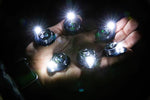
Basics of LED Lighting
, by Chas Waters, 3 min reading time

, by Chas Waters, 3 min reading time
Most of us have seen those big-budget blockbuster movies depicting what the future will look like with visions of flying cars, fully automated everyday fixtures and sophisticated robotics creating a bigger, cleaner and more innovative world. While many of these advancements are still far off, the first step to this shiny and modern future is already here in the form of LED lighting. LED bulbs are now included in a variety of different products and applications because of their exceptional energy efficiency, non-toxic, eco-friendly design and versatile usage.
LED lighting is a sophisticated technology that is greatly different than the sources of lighting most people are familiar with, such as incandescent and fluorescent bulbs. To best use LEDs in your everyday life, you should understand how they work and their best uses — but let’s start at the basics of LED lighting.
An LED — light-emitting diode — is a semiconductor light source that turns electrical energy into light. When an electrical current flows through the diode, traveling in one direction from the diode’s positive side to the negative side, it emits light. They require much less power to operate and produce more energy-efficient light than traditional incandescent light bulbs.
Previously, when you went to the store to pick up new incandescent lightbulbs, you likely only checked the bulb’s wattage and possibly its lifespan, happily settling for whichever brand was on sale that week. When selecting LED bulbs, you’ll find there’s a variety of different products and terms describing the LED’s performance. But what, exactly, is a lumen or the bulb’s efficacy and wattage consumption, and how does that compare to traditional bulbs? Don’t get frustrated and reach for those inefficient incandescent bulbs — here are some of the most popular LED specs explained:
At Panther Vision, see a clearer and brighter world with our wide selection of revolutionary hands-free lighting products. When you wear our popular POWERCAP® lighted hats, BUTTON LAMPS™or LIGHTSPECS™ reading glasses, you’ll realize why so many of our customers have found they can’t live without our quality, ultra-bright LED solutions for all of their everyday and outdoor needs. Shop LED hands-free lighting apparel and devices today to find the perfect product for your lifestyle.